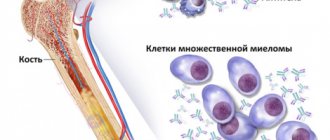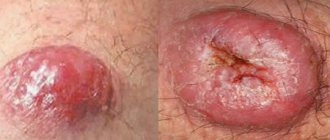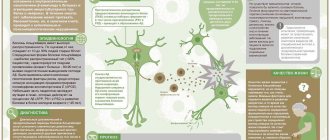The main symptoms of Addison's disease are lethargy, increased heart rate, abdominal pain and a bronzed skin tone. This disease is rare and affects middle-aged people. Its cause is adrenal insufficiency, which is caused by: autoimmune inflammation (adrenalitis); tuberculosis; fungal infection; amyloid protein deposition; accumulation of iron salts in hemochromatosis; tumor metastases from the intestine, breast or lung tissue; viral diseases (cytomegalovirus and HIV).
In 65% of patients, the main factor is the formation of antibodies against their own cells of the adrenal glands. Most often found in women. With congenital lesions of the adrenal gland , low activity of the thyroid gland, thrush, underdevelopment of the genital organs, baldness, anemia, active hepatitis, and vitiligo are often simultaneously detected.
With the second type of widespread damage, diabetes mellitus, autoimmune thyroiditis and decreased adrenal function appear in adulthood.
Nonspecific manifestations of Addison's disease lead to the fact that patients often receive treatment for similar diseases. The most typical symptoms include : general weakness; rapid fatigue with minor physical exertion; weight loss; low blood pressure, fainting when changing body position; joint and muscle pain; increased craving for salty foods, loss of appetite; abdominal pain, vomiting, diarrhea; memory loss, lethargy, depression; neurosis, psychosis; tingling and numbness of the limbs.
General weakness increases towards the end of the day. Subsequently, motor activity decreases, speech becomes slow and the voice becomes quiet. Patients note an increase in weakness during infections and digestive disorders.
Melanin deposition is one of the most noticeable symptoms of Addison's disease. First, those parts of the body that come into contact with clothing, are exposed to the sun and already have color darken. Pigmentation then covers the entire skin. Exclusively in cases of autoimmune origin of the pathology, uncolored spots of vitiligo appear against the background of dark skin. One of the features is the deposition of calcium in the ear cartilage area .
When exposed to stress, the need for cortisol increases sharply. If the response cannot provide the required amount of hormone, then Addisonian crisis develops.
It refers to conditions that threaten life. Signs: sharp pain in the lower back, abdomen, lower extremities; uncontrollable vomiting, diarrhea, copious urine output, leading to severe dehydration; drop in pressure to the point of shock; loss of consciousness, delirium, psychosis; convulsions.
General diagnostics and tests: blood test for cortisol, ACTH, electrolytes; blood biochemistry; urine analysis, ultrasound, ECG.
Treatment of bronze disease:
- Drugs. Hydrocortisone is used. Its initial dose is 30 mg. Prednisolone and Dexamethasone may also be prescribed. If aldosterone deficiency is also detected, then Doxa or Cortineff is added to therapy. During childbirth and surgery, hydrocortisone is administered in a dropper. If the patient has an infectious disease, the dosage of hormones increases 2-4 times. If a crisis threatens or occurs, intensive hormonal therapy in a hospital setting is indicated.
- Diet. It is necessary to ensure a sufficient supply of protein, carbohydrates, fats, table salt and vitamins, especially ascorbic acid and group B. Alcohol intake is prohibited. Potassium is limited in the diet. Undesirable foods: cooking oil, refractory fats, lard, fatty meats, smoked meats, canned food, fried foods, marinades, sausages, bananas, figs, dried apricots, apricots, raisins and potatoes.
Read more in our article about Addison's disease, its manifestations and therapy.
General information
Addison's disease is a chronic failure of the adrenal cortex, manifested in a decrease or cessation of the secretion of hormones - mineralocorticoids and glucocorticoids ( aldosterone , cortisol , cortisone , corticosterone , deoxycorticosterone and other corticosteroids).
A deficiency of mineralocorticoid hormones leads to increased sodium excretion and decreased potassium excretion, mainly in urine, but also in sweat and saliva, while electrolyte imbalance causes severe dehydration, plasma hypertonicity, acidosis , decreased circulating blood volume, hypotension and even circulatory collapse . However, if the pathology is caused by decreased ACTH , electrolyte levels remain normal or moderately altered. Whereas a lack of glucocorticoids causes the following symptoms of Addison's disease: changes in insulin and impaired carbohydrate, protein and fat metabolism. As a result, carbohydrates necessary for life are formed from proteins, blood sugar levels decrease, glycogen deposited in the liver are depleted, which is expressed in general, muscle, and including myocardial weakness. Patients' resistance to viruses and infections, injuries and various types of stress . As failure develops, cardiac output decreases and circulatory failure occurs.
If the level of plasma cortisol is reduced, then ACTH synthesis is stimulated and the level of β-lipotropic hormone , which has melanocyte-stimulating activity, which, together with tropin, produces hyperpigmentation . People not only have bronze skin, but also mucous membranes. This means that secondary failure resulting from functional disorders of the pituitary gland does not manifest itself in the form of hyperpigmentation.
This endocrine disorder is quite rare - 4-6 people per 100 thousand in statistics from different countries. It was first described by the English physician, the father of endocrinology, Thomas Addison back in 1855 in the book “On the Constitutional and Local Consequences of Diseases of the Adrenal Cortex.”
Thomas Addison and his book
Symptoms in women, men, children
Nonspecific manifestations of Addison's disease lead to the fact that patients often receive treatment for similar diseases, take many medications for a long time and unsuccessfully until the doctor prescribes an examination of the adrenal glands. The most typical symptoms include:
- general weakness;
- rapid fatigue with minor physical exertion;
- weight loss;
- low blood pressure, fainting when changing body position (orthostatic hypotension);
- joint and muscle pain;
- increased craving for salty foods, loss of appetite, nausea;
- abdominal pain, vomiting, diarrhea;
- memory loss, lethargy, depression;
- neurosis, psychosis;
- tingling and numbness of the limbs.
The patient often cannot accurately indicate the onset of the disease, since its first manifestation is general weakness, which increases towards the end of the day (with neurasthenia, there is an improvement in well-being in the evening). Subsequently, motor activity decreases, speech becomes slow and the voice becomes quiet. Patients note an increase in weakness during infections and digestive disorders. Dehydration, nausea, loss of appetite, and vomiting lead to progressive weight loss.
Melanin deposition is among the most noticeable feature of Addison's disease . First, those parts of the body that come into contact with clothing, are exposed to the sun and already have color (for example, lips, nipple areolas) darken. Pigmentation then covers the entire skin.
Skin pigmentation in Addison's disease
This can be noticed by the darkening of fresh scars and an increase in the density of freckles. Exclusively in cases of autoimmune origin of the pathology, uncolored spots of vitiligo appear against the background of dark skin. One of the features is the deposition of calcium in the ear cartilage area.
Pathogenesis
There are many mechanisms of damage to the adrenal cortex, causing insufficiency in the production of hormones - hypocorticism , or their complete absence - acorticism . These include:
- autoimmune reactions (in 85% of cases) - antibodies to the adrenal cortex are synthesized in the body - immunoglobulins M , lymphoid infiltration, fibrosis and atrophy of functioning glandular cells occur;
- infections – introduced into the adrenal glands hematogenously, most often causing caseous necrosis and calcification;
- underdevelopment ( hypoplasia );
- oncology;
- genetic defects and diseases, such as hemochromatosis ;
- injuries;
- poisoning;
- impaired sensitivity or synthesis of adrenocorticotropic hormone (ACTH) as a result of ischemia, radiation, etc.
The structure of the adrenal glands
Hormones of the adrenal cortex and their significance
Hormones produced in the morphofunctional cortical layer of the adrenal glands are corticosteroids . Among them, the most active and important are:
- Cortisol is a glucocorticoid synthesized in the zona fasciculata of the cortex. Its main function is the regulation of carbohydrate metabolism, stimulation of gluconeogenesis and participation in the development of stress reactions. The conservation of energy resources is realized through the binding of cortisol to liver receptors and other target cells, which causes activation of glucose , its storage in the form of glycogen against the background of a decrease in catabolic processes in the muscles.
- Cortisone is a glucocorticoid, second in importance after cortisol, which can stimulate the synthesis of carbohydrates and proteins, inhibit the immune system, and increase the body's resistance to stressful situations.
- Aldosterone is the main human mineralocorticoid, synthesized in the zona glomerulosa of the cortex, under its action tissues are able to retain water and chlorides, sodium reabsorption and potassium excretion are enhanced, a shift towards alkalosis occurs, blood pressure and circulating blood volumes increase.
- Corticosterone is a less significant mineralocorticoid hormone; it also has glucocorticoid activity, although half that of cortisol, which is realized primarily in stimulating liver gluconeogenesis.
- Deoxycorticosterone is a minor, low-active mineralocorticosteroid hormone that can regulate water-salt metabolism and increase the strength and endurance of striated muscles.
Possible causes and mechanism of development of disorders
For primary failure, the reasons may be:
- autoimmune effects (idiopathic atrophy of the adrenal cortex), researchers from the USA believe that this includes up to 70% of cases of the disease, reports have appeared on the significance of AIDS;
- tuberculosis, syphilis;
- amyloidosis;
- underdevelopment of the glandular apparatus (hypoplasia);
- adrenal tumor or metastases to it;
- destruction of glandular tissue by toxic substances;
- genetic disorders in the process of synthesis of hormonally active substances;
- decreased sensitivity of adrenal tissue to “orders” from higher centers transmitted by adrenocorticotropic hormone of the pituitary gland (ACTH).
A tumor of the left adrenal gland compresses the glandular cells, causing their destruction
In secondary adrenal insufficiency (called hypothalamic-pituitary), the main factor in pathogenesis is damage to the anterior pituitary gland with a lack of adrenocorticotropic hormone. Its concentration in the blood is not enough to stimulate the glandular cells of the adrenal glands.
The reasons arise due to:
- local tumor in the brain stem or pituitary gland;
- consequences of ischemic attack, stroke;
- prolonged stressful situations;
- head injuries;
- radiation therapy of the brain for certain diseases;
- birth injuries in children in the first days of life;
- hormonal changes in women during pregnancy and menopause.
Addison's disease in such cases is often combined with decreased thyroid function, diabetes mellitus, and polyglandular deficiency syndrome (of all endocrine glands).
Classification
Depending on the mechanism of development of Addison's or otherwise bronze disease, the following are distinguished:
- primary insufficiency of the adrenal cortex - the basis of the pathology is damage to the glandular structures directly;
- secondary failure - as a result of a violation of the hypothalamic-pituitary system , which normally should stimulate the adrenal cortex.
Acute adrenal insufficiency is called hypoadrenal or Addison's crisis .
Features of Addisonian crisis
Addisonian crisis develops suddenly and can threaten a person’s life. Low concentrations of hormones (cortisol, aldosterone) in the bloodstream lead to loss of consciousness or psychosis, confusion, delirium, fever , severe vomiting and diarrhea , mineral and water imbalances, pain in the legs, lower back, abdomen, low blood pressure and even cause shock .
Possible complications and consequences
The most dangerous complication of Addison's disease is the development of Addisonian crisis, a life-threatening condition.
The reasons for its occurrence may be:
- stress (surgery, emotional stress, trauma, acute infectious diseases);
- removal of both adrenal glands without adequate hormone replacement therapy;
- bilateral adrenal vein thrombosis;
- bilateral embolism of the adrenal arteries;
- bilateral hemorrhage in the adrenal tissue.
Causes
Addison's disease and adrenal hypofunction can develop as a result of such processes and pathologies as:
- tuberculous, syphilitic, brucellosis lesions;
- purulent inflammation;
- decreased sensitivity or ACTH deficiency;
- taking exogenous corticosteroids, which provokes adrenal atrophy;
- development of non-hormone-producing tumors;
- congenital dysfunction;
- sarcoidosis;
- amyloidosis;
- drug therapy, for example, chlodatin , etomidate , spironolactone , ketoconazole , as well as barbiturates, steroidogenesis blockers.
Prevention
Unfortunately, at the moment there are no preventive measures that would help a person avoid the development of pathology. All you can do is monitor your health to avoid developing conditions that could trigger the development of the disease.
So, Addison's disease is a very serious pathology, but with proper therapy it has a favorable prognosis. It does not affect a person’s life expectancy in any way, so taking hormonal medications does not affect the quality of life.
Author: Anastasia Mironova, doctor, especially for Nefrologiya.pro
Symptoms of Addison's disease
The symptoms of Addison's disease are most acute under stress, when the sympathetic-adrenal system is depleted and the body experiences an increased need for glucocorticoids. The pathology develops slowly and may not be noticed for several months or even years, while it progresses, and the patient experiences:
- chronic fatigue;
- muscle weakness;
- increased irritability, anxiety, restlessness, tension and short temper;
- depressive disorder;
- thirst and need to drink plenty of fluids;
- strong heartbeat and development of tachycardia ;
- changes in taste in favor of salty and sour;
- flushes of nausea, dysphagia (impaired swallowing), digestive system disorders - vomiting, diarrhea, abdominal pain;
- loses weight and loses appetite;
- dehydration and excessive urine production ( polyuria );
- tetany, paralysis, tremors and convulsions , especially after consuming dairy products and the phosphates that accumulate as a result;
- paresthesia and deterioration of sensitivity of the limbs;
- decreased levels of glucose in the bloodstream ( hypoglycemia );
- decrease in the amount of circulating blood ( hypovolemia ).
In addition, arterial and, quite often, orthostatic hypotension develops. In women, from the reproductive system, adrenal depletion causes disruption of the menstrual cycle; in men, erectile dysfunction .
Important! One of the most specific manifestations of the disease described by Addison is hyperpigmentation of the skin of those areas that are exposed to solar radiation or greater friction. Dark spots - melasma - appear all over the body and even on the gums, which is why the pathology is also known as bronze disease. Only 10% of patients do not have this symptom and this pathology is called “White Addison” .
Another pathology is known, described by Addison and manifested in the form of yellowness of the integument - Addison-Birmer anemia , develops with a deficiency of vitamin B12 and is also called pernicious anemia or malignant anemia .
Addison-Birmer disease: symptoms and features
The pathology is based on atrophy of the gastric mucosa and cessation of secretion of Castle factor . Most often occurs in older people and people over 40 years of age. In addition to the autoimmune mechanism, the cause may be strict vegetarianism , cancer, helminthiasis, gastrectomy and enteritis .
Symptoms of Addison-Beermer disease include burning of the tongue, sensitivity, dryness and inflammation of the mucous membranes, fatigue, dizziness, migraines , shortness of breath , increased heart rate, daytime drowsiness and nighttime insomnia . At the same time, dyspeptic disorders are added - anorexia , diarrhea . Very often, patients seek medical help with significant anemia.
Addison-Biermer anemia is treated with injections of vitamin B12 , and is also aimed at normalizing hemoglobin .
Treatment
An important place in the treatment of Addison's pathology is occupied by a diet with a fractional diet. To ensure restoration of body weight, restore the patient’s ability to work and develop immunity, the total calorie content of meals should be 25% more than what nutritionists recommend for a normal state of health for a given age. To eliminate hypovitaminosis during adrenal disease, doctors prescribe ascorbic and nicotinic acid, thiamine, riboflavin, vitamins A and E. The dose is calculated individually.
Of the synthetic glucocorticoids and mineralocorticoids, Deoxycorticosterone, Hydrocortisone, Cortisone, Aldosterone, Fludrocortisone are indicated as drugs for Addison's pathology. Replacement therapy with corticosteroids is carried out for life, so the patient is under constant medical supervision for the necessary adjustment of drug dosage.
In order to normalize glucose levels during Addison's pathology, it is administered intravenously (5% solution). To replenish fluid volume, the patient is prescribed saline sodium chloride solution (intravenously). In severe cases of Addison's disease, surgical treatment is prescribed, which consists of surgical removal of the adrenal glands. After surgery, the body's need for glucocorticoids does not disappear, so the use of synthetic hormones continues.
Tests and diagnostics
To confirm Addison's disease you need to do:
- ultrasound examination of the adrenal glands to identify lesions, for example in tuberculosis ;
- blood test to determine the level of adrenal hormones (cortisol), ACTH, glucose, potassium, sodium, renin ;
- CT scan of the adrenal glands, which allows you to detect adrenal infarction, reduction in size, tumor metastases, amyloidosis;
- MRI of the brain to study the hypothalamic-pituitary region and detect destructive, tumor or granulomatous processes.
The basis for diagnosing Addisonian crisis is:
- a decrease in sodium concentration in the bloodstream below 130 mmol/l, excretion in urine - less than 10 g per day;
- an increase in potassium concentration in the bloodstream over 5 mmol/l;
- a drop in the ratio of sodium to potassium ions to 20 units (normally 32);
- low glucose levels;
- development of acidosis;
- high concentrations of urea , residual nitrogen in blood plasma tests.
Addisonian crisis
The adrenal glands are an organ that provides a response to any stress. During such periods, the need for cortisol increases sharply. If the response cannot provide the required amount of hormone, then a crisis develops. It refers to conditions that threaten life.
A crisis can occur due to unrecognized Addison's disease, an incorrectly selected dose of medication, or, what most often happens, uncorrected therapy due to stress, surgery, injury, pregnancy, bleeding, or infection.
Any concomitant disease, climate change, or temperature increase the risk of worsening adrenal insufficiency.
Manifestations of Addisonian crisis include:
- sharp pain in the lower back, abdomen, lower extremities;
- uncontrollable vomiting, diarrhea, copious urine output, leading to severe dehydration;
- drop in pressure to the point of shock;
- loss of consciousness, delirium, psychosis;
- convulsions.
Drop in blood pressure to the point of shock
Diet for adrenal insufficiency
Diet 15 table
- Efficacy: therapeutic effect after 2 weeks
- Timing: constantly
- Cost of food: 1600-1800 rubles per week
In addition to the fact that the patient needs to avoid hypothermia and stressful situations, a diet rich in carbohydrates is recommended. You need to add foods with a high amount of ascorbic acid (black currants, citrus fruits, rosehip decoction) and an additional 15-20 g of table salt per day to your diet.
To prevent hyperkalemia, it is better to limit the consumption of potassium-rich dried apricots, raisins, legumes, and potatoes.
What determines the development of the iatrogenic form?
Doctors are forced to identify an iatrogenic form of the disease, depending on the treatment used. Modern therapy for many systemic diseases cannot do without corticosteroids. They are prescribed, for example, to patients with psoriasis, lupus erythematosus, asthma, ulcerative colitis, autoimmune thyroiditis and other pathologies of internal organs.
Patients have to take long-term courses of drugs for health reasons. In this case, the adrenal gland’s own glandular cells atrophy, and the connection with the hypothalamic-pituitary regulatory system is broken. If you stop taking the drugs, a “withdrawal syndrome” develops with severe deficiency. The dosage reduction must be carried out in stages.
Useful tips
- If a patient requires surgery for any reason, hormones are started intravenously the day before surgery and maintained until the patient is able to take the required amount of medications and fluids by mouth on their own.
- With proper treatment, women with Addison's disease can become pregnant and have a healthy baby. In case of vomiting during pregnancy, hormones should be replaced by injection. Hormone replacement therapy during pregnancy is no different from that prescribed to non-pregnant women. During delivery, the procedure should be the same as described for the operation.
- The patient must learn to monitor his illness and take care of himself. This requires learning about the symptoms of hormonal imbalance. If you suspect an attack, you should immediately seek help. The patient should always carry the ampoule of glucocorticoids prescribed by the attending physician with him so that specialists can immediately administer the injection. It is also recommended to always have a document with you describing the disease.
The patient should always take routine glucocorticoid injections as prescribed by the doctor. Of course, the dosage must be strictly adjusted in accordance with the instructions of the endocrinologist. An immediate injection may be necessary, for example, in cases of severe infections, vomiting and diarrhea, which increase the risk of Addison's crisis.
UP
Sign up
Ask a Question
If you find an error, please select a piece of text and press Ctrl+Enter.
Share link:
Time to take glucocorticoids
If you constantly have to take glucocorticoids in significant dosages, then over time the function of your own adrenal glands decreases. There is no need to produce your own steroid hormones, since they are constantly and in abundance supplied from the outside. Experts recommend taking glucocorticoids in the morning to reduce the risk of adrenal insufficiency. Morning intake coincides with the peak activity of your own adrenal glands and simulates the natural daily rhythm of fluctuations in cortisol levels. Most glucocorticoid drugs are taken once a day because they have a sufficient duration of action. If you are advised to take these drugs 2 or 3 times a day, in most cases the dosage ratio is such that the maximum is still in the morning to avoid the complications described above. The only exceptions may be short-term dosage regimens.
Taking glucocorticoids too late can not only increase the risk of developing adrenal insufficiency, but also provoke insomnia.
Skin pigmentation
Violation of uniform skin color or the appearance of pigmentation is the most important, conspicuous symptom. Abundant deposition of melanin (a pigment that does not contain iron) in the cells of the malpighian layer of the epidermis contributes to the appearance of brown, bronze or smoky spots on the skin. Starting on the face, pigmentation can cover the entire surface of the skin or be localized in certain places: forehead, interphalangeal joints, neck, nipples, scrotum, around the navel, etc.
Sometimes large dark spots appear on the face. The lips, nipples, mucous membranes of the vagina and intestines in women are stained bluish. Along with severe pigmentation disorders, the patient has areas of skin that are weakly pigmented or even completely devoid of melanin, which stand out sharply against the background of the surrounding dark skin - the so-called vitiligo, or leucoderma. In the primary form of Addison's disease, this symptom appears one of the first, and it can be several years ahead of other signs of the disease.
Therapeutic measures
How should Addison's syndrome be treated? Patients with this diagnosis must take corticosteroids. Very often this is enough to stop the disease, but there are situations when mineralocorticoids are added to the prescription.
In doctors’ protocols, the drug of choice is hydrocortisone at a dosage of no more than 30 milligrams per day. Cortisone is recommended at 40 milligrams per day, but substances such as dexamethasone and prednisolone are not used because they do not have mineralocorticoid activity.
If there is a diagnosis such as “mineralocorticoid deficiency,” the doctor prescribes DOXA and Cortinef to the patient in a dose of 0.05 to 0.1 milligrams per day.
If you exceed the dose of mineralocorticoid, negative reactions may develop, which are characterized by the appearance of:
- swelling;
- pain in the temples and back of the head;
- increase in blood pressure;
- muscle weakness;
- hypokalemic alkalosis.
This situation requires the abolition of mineralocorticoids and the administration of potassium chloride. The doctor also recommends that the patient use increased amounts of salt and vitamin C in his diet.
Women who have a history of chronic adrenal insufficiency can become pregnant and give birth to a child on their own. It is worth noting that during gestation there is a physiological increase in the production of progesterone, which makes it possible to reduce the dosage of mineralocorticoids. There are situations when the amount of glucocorticoids used needs to be increased, and in particularly difficult cases they resort to parenteral administration of hydrocortisone. During delivery, glucocorticoids are usually used intravenously.
When a patient is diagnosed with pathologies that have a mild or moderate course, the dose of glucocorticoids is doubled or even tripled.
If the illness is accompanied by vomiting and an adrenaline crisis, then the patient continues further treatment in a hospital setting. Surgery is performed only in the case of intravenous administration of hydrocortisone in a dose of 100 to 200 mg, which depends on the type of surgical procedure. After surgery, it is important to quickly reduce large doses of the drug during the first three days, after the stressful situation has been eliminated.
What is the basis of the disease?
What kind of disease is this and why Addison? Addison's disease is a hormonal disease that is caused by low levels of a certain secretion produced by the adrenal gland.
Such a deficiency can be primary or secondary.
Primary type deficiency
Primary adrenal insufficiency was defined as a separate disease. The described disorder was named after the person who initiated his research - Addison's disease.
This form is formed due to the fact that the adrenal cortex is damaged. After damage and changes in the structure of the adrenal gland, it becomes no longer capable of producing cortisol (F-compound 17-hydrocortisone) and, often, aldesterone, in normal quantities.
Secondary type deficiency
Secondary adrenal insufficiency occurs when there is a violation of the amount of adrenocorticotropin secretion produced.
ACTH is produced by the pituitary gland and is responsible for stimulating the cortisol-producing function of the adrenal glands.
In the case when adrenocorticotropin is synthesized too slowly, the levels of the blood hormone cortisol rapidly fall.
In the long-term absence of regulating ACHT, the glands may completely lose their ability to produce secretions.
Secondary deficiency is a more common disorder of hormone secretion than Addison's disease.
Weight gain
Taking glucocorticoid medications has serious effects on your metabolism. Large doses of stress hormone in the blood are vital for some diseases, but in ordinary life they help to survive a serious crisis. And during a crisis, food reserves are especially important, so taking such drugs will make you constantly feel hungry. The higher the dose and the longer the duration of therapy, the more likely you are to gain weight. It is very important to follow a low-calorie, sodium-restricted diet when taking glucocorticoids. In this case, the diet should include foods that will meet your increased needs for potassium and calcium. A diet high in protein and low in carbohydrates will help to significantly reduce the unwanted effects of taking glucocorticoids.
Diagnosis of adrenal insufficiency
The doctor makes the first assumption of the diagnosis based on the patient’s medical history and a detailed analysis of symptoms and signs. This hypothesis is then tested through a series of surveys and tests.
Blood test, which should note:
- Low cortisol levels.
- High ACTH levels.
- Low cortisol response to ACTH stimulation.
- The presence of specific antibodies to the adrenal system.
- Sodium level is below 130.
- Potassium level is more than 5.
Measuring glucose levels after insulin administration. The patient is given insulin and blood sugar and cortisol levels are assessed at regular intervals. If the patient is healthy, blood sugar levels decrease and cortisol levels increase.
ACTH stimulation of the adrenal glands. The patient is injected with synthetic adrenocorticotropic hormone, and then the cortisol concentration is measured. Low levels indicate adrenal insufficiency.
Computed tomography of the abdominal cavity. Determines the size and any abnormalities of the glands.
Magnetic resonance imaging of the sella turcica (the area of the skull where the pituitary gland is located). Identifies possible malfunctions in the pituitary gland.
How to reduce complications
In order to reduce the rate of development of complications caused by constant use, the following measures are necessary.
- Constantly monitor your body weight and follow a low-calorie diet.
- Regularly measure blood pressure and promptly adjust antihypertensive therapy.
- Monitor carbohydrate metabolism and adjust glucose-lowering therapy.
- Additionally, take calcium and vitamin D3 supplements, bisphosphonates or sex hormones as prescribed by your doctor and follow the required physical activity regimen.
- Follow the diet and medication intake on time, and also take antacids if necessary.
- Get regular checkups with an ophthalmologist.
- Prevent infectious complications by limiting contact with infected people and observing personal hygiene rules. Undergo regular medical examinations and the necessary studies to exclude indolent infectious processes.
- Strictly follow the rules for drug withdrawal. Discontinuation of glucocorticoids, if they have been used for more than 10 days, should occur under the supervision of a physician. If glucocorticoids are successfully discontinued, then for 1.5–2 years there remains a need to monitor the patient’s condition in stressful situations.
Adrenal glands and endocrine regulation of the body
The adrenal glands are paired glands located in the retroperitoneal space above the kidneys and closely adjacent to them. They have different shapes - the left one is in the form of a hemisphere, the right one is in the form of a pyramid. The adrenal glands have two independent parts - the cortex and the medulla - and play a primary role in the regulation of endocrine processes.
The adrenal glands produce hormones:
- adrenaline and norepinephrine;
- cortisol and corticosterone;
- aldosterone;
- testosterone, estrogen.
The activity of the adrenal glands in producing hormones is regulated by the main endocrine organs - the hypothalamus, pineal gland and pituitary gland. When the concentration of hormones in the body decreases, a corresponding signal is sent to the brain - in response, the pituitary gland releases adrenocorticotropic hormone, under the influence of which the adrenal glands produce hormones.
The role of hormones produced by the adrenal glands is great. They are responsible for:
- maintaining optimal metabolism;
- establishing water-salt balance;
- lipid metabolism;
- optimization of the body's immune response;
- stabilization of blood pressure;
- stimulation of sexual desire, development of secondary sexual characteristics.
Carbohydrate metabolism and blood pressure
People with diabetes who take glucocorticoids will notice that their blood glucose is out of control with their usual medications. They will have to significantly increase the dosage of glucose-lowering drugs. Blood sugar may rise even if a person has not previously had any disturbances in carbohydrate metabolism. This disorder is called steroid diabetes mellitus, it can go away after stopping the drugs, or it can transform into type 2 diabetes mellitus.
A similar situation occurs in patients with arterial hypertension. People who have not previously had episodes of high blood pressure may find that the numbers on the tonometer become noticeably higher. Patients with hypertension will likely require increased doses of medications to control the disease.
How glucocorticoids work
These medications are analogues of cortisone and cortisol - hormones that are produced by our adrenal glands in small quantities constantly, but under stress or some disease their production increases many times over. Glucocorticoids can suppress our immune system and reduce inflammatory responses. That is why they are able to suppress or reduce the activity of many autoimmune inflammatory processes and prevent or eliminate any manifestations of allergies.
Prednisolone and its analogs cannot be classified as anabolic steroids, which are used by people who dream of quickly and without great physical effort to increase their muscle mass.
Increased risks of infection
Prednisolone and its analogues suppress the immune system, so their use increases the risk of developing any infectious diseases. Most often this manifests itself as an increased susceptibility to acute respiratory viral infections and skin infections. However, we must remember that in patients receiving high doses of glucocorticoids for a long time, the risk of developing dangerous infections such as tuberculosis and systemic mycoses increases.
Addison's disease clinic
The disease develops gradually, general weakness increases, malaise, anorexia, nausea and vomiting, weight loss, vague abdominal pain, and skin pigmentation appear.
The latter is more pronounced on open parts of the body, areas exposed to friction, skin folds, and postoperative scars. Dark gray spots also appear on the mucous membranes of the lips, cheeks, tongue, and palate. Pigmentation is caused by increased secretion of melanocyte-stimulating hormone, formed from the precursor ACTH. Hyperpigmentation can occur later than other symptoms, and sometimes is absent altogether. It is almost impossible to detect in people with naturally dark skin color. Aldosterone deficiency leads to hyponatremia and hyperkalemia. Such patients are characterized by arterial hypotension with orthostatic phenomena. An ECG often shows a decrease in wave voltage, flattening or biphasic T waves, and widening of the QRS complex. Neuropsychic disorders with increased excitability and, less commonly, depression are characteristic. Psychosis and sometimes paresthesia and convulsions may develop. Manifestations of the disease intensify during injury, infection, during which adrenal crises may occur - nausea, vomiting, fever, severe abdominal pain, sometimes adynamia, collapse, even the development of prostration. Due to a lack of androgens, a decrease in the amount of hair in the armpits is possible, especially in women. In mild forms of the disease, routine laboratory values often remain normal. Later, hyponatremia and hyperkalemia appear, the amount of extracellular sodium and extracellular fluid decreases, and the plasma levels of angiotensin II and antidiuretic hormone increase. Hypercalcemia sometimes occurs. It is a significant disturbance of electrolyte metabolism that leads to changes in the ECG. The blood may show normocytic anemia, lymphocytosis, and moderate eosinophilia. To recognize the disease, laboratory testing of the function of the adrenal cortex is of great importance. A decrease in the content of 17-hydroxycorticosteroids in the blood and urine is detected, and the secretion of aldosterone is also reduced. Of particular importance is the study of the reserve function of the adrenal cortex under the influence of ACTH. 30-60 minutes after the administration of ACTH, the level of hydrocortisone in the blood increases to a lesser extent than normal. The level of ACTH in the blood of patients with Addison's disease can be significantly elevated. With secondary hypocortisolism, in contrast to primary hypocortisolism, after ACTH loading, the excretion of corticosteroids increases. It should be remembered that altered results of a study of the function of the adrenal cortex are found in a number of other pathological conditions, in particular liver diseases, hypothyroidism, tumors, and cachexia. Addison's disease or bronze disease is a long-term disease associated with dysfunction of the adrenal glands. This disease affects the outer cortex of the adrenal glands, which under normal conditions produces several types of hormones.
Addison's disease is characterized by a long, progressive course. The prevalence of the disease is not very high, with bronze disease affecting approximately 4 people in every 100,000 population. Bronze disease is equally common in both sexes. Basically, the disease is diagnosed in middle age, between 20 and 40 years.
A severe complication of bronze disease is the development of adrenal crisis, which most often occurs as a consequence of an infectious disease or severe nervous shock.
Why does the disease occur?
Addison's disease is caused in most cases by autoimmune inflammation. Antibodies to the body’s own cells produce protective systems. The immune system mistakes the adrenal cortex for foreign tissue and begins to destroy it. When most of the endocrine cells have already died, the first symptoms of bronze disease appear.
What can trigger autoimmune aggression? Doctors cannot answer this question unequivocally. Probably, the pathology of the body's defenses is associated with heredity, genetic mutations, excessive insolation (sunlight, solarium), and unfavorable environmental conditions.
The autoimmune process is the cause of 80–90% of cases of the disease. Destruction of the adrenal cortex can also occur for other reasons. Thus, in unfavorable social conditions the disease provokes tuberculosis. Today, this infection is the cause of about 10% of all cases of chronic adrenal insufficiency.
Less commonly, the cause of the disease is trauma, surgical destruction, thrombosis, benign or malignant tumor.
Whatever the cause of primary adrenal insufficiency, its clinical picture and treatment principles differ slightly.
How is the diagnosis made?
If primary adrenal insufficiency is suspected, an examination is carried out by an endocrinologist. Diagnosis of Addison's disease includes a standard or short adrenocorticotropin test. Additionally, the patient is prescribed a blood test for cortisol, renin, blood sugar, electrolytes, adrenocorticotropin and a complete blood count.
The disease is characterized by:
- there is no sufficient increase in cortisol levels during testing;
- blood cortisol is reduced;
- renin and ACTH are increased;
- hyponatremia;
- hyperkalemia;
- an increase in neutrophils and eosinophils in a general blood test;
- hyperglycemia (increased blood sugar).
How does the disease manifest itself?
Symptoms of adrenal insufficiency may go undetected for a long period. The patient's fatigue and weakness gradually increase. He becomes less active, it is more difficult for him to do his usual work. After a night's sleep, symptoms become less pronounced.
Changes in the function of the central nervous system cause absent-mindedness, memory loss and sleep disturbances. The patient becomes hot-tempered and irritable. He finds fault with everything and is dissatisfied with everything. A person’s internal tension increases, he becomes restless and anxious. Nervous stress can cause deep depression.
Against the background of loss of appetite, body weight decreases and muscle weakness develops. Indigestion is manifested by vomiting, diarrhea, nausea. The abdomen may feel heaviness and pain. The disease causes a decrease in blood pressure, especially in an upright position. Both upper and lower pressure decreases. The pulse is soft, small and slow. Against the background of low blood pressure, attacks of rapid heartbeat may appear. Patients suffer from shortness of breath.
A characteristic feature is increased skin pigmentation. Brown spots may appear on the mucous membrane of the mouth, as well as on the teeth. A decrease in the amount of sex hormones leads to the absence of menstruation in women and impotence in men. An insatiable craving for salt develops. The patient may eat handfuls of salt, especially in the afternoon. There are signs of dehydration: dry mouth, severe thirst, dizziness. Due to the consumption of large amounts of liquid, the patient experiences frequent urination. The amount of circulating blood decreases, and glucose levels drop. Convulsive attacks appear caused by disturbances in calcium metabolism in the body. They often occur after drinking milk. The patient's limbs and head are trembling. There may be difficulty swallowing (feeling of a lump in the throat, pain, food getting into the nose).
When a feeling of hunger appears, hypoglycemic conditions may occur. They are accompanied by increased sweating and trembling of the fingers. The skin becomes pale.











